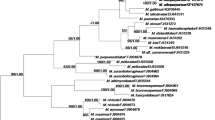Abstract
A lethal mushroom that caused two deaths in southwestern China in 2014 drew our attention. Morphological and molecular phylogenetic data indicated that the mushroom belongs to Amanita section Phalloideae and is distinct from all known taxa of the section. The novel species, designated A. subpallidorosea, has been described and compared with related taxa in the genus. This species is macroscopically characterized by a white pileus when juvenile that develops a pale rose tinge in the center with age, a subapical annulus, and large globose to subglobose basidiospores measuring 8.5–11 × 8–10 μm.




Similar content being viewed by others
References
Bas C (1969) Morphology and subdivision of Amanita and a monograph of its section Lepidella. Persoonia 5:285–579
Bas C (2000) A broader view on Amanita. Boll Gruppo Micologico G Bresadola 43:9–12
Bresinsky A, Besl H (1990) A colour atlas of poisonous fungi: a handbook for pharmacist, doctor and biologist. Wolf Publishing Ltd, London
Cai Q, Tulloss RE, Tang LP, Tolgor B, Zhang P, Chen ZH, Yang ZL (2014) Multi-locus phylogeny of lethal amanitas: implications for species diversity and historical biogeography. BMC Evol Biol 14:143. doi:10.1186/1471-2148-14-143
Chen ZH (2014) New advances in researches on poisonous mushrooms since 2000. Mycosystema 33:493–516
Chen ZH, Hu JS, Zhang ZG, Zhang P, Li DP (2003) Determination and analysis of the main amatoxins and phallotoxins in 28 species of Amanita from China. Mycosystema 22:565–573
Chen ZH, Zhang P, Zhang ZG (2014) Investigation and analysis of 102 mushroom poisoning cases in Southern China from 1994 to 2012. Fungal Divers 64:123–131. doi:10.1007/s13225-013-0260-7
Chenna R, Sugawara H, Koike T, Lopez R, Gibson TJ, Higgins DG, Thompson JD (2003) Multiple sequence alignment with the Clustal series of programs. Nucleic Acids Res 31:3497–3500. doi:10.1093/nar/gkg500
Corner EJH, Bas C (1962) The genus Amanita in Singapore and Malaya. Persoonia 2:241–304
Felsenstein J (1985) Confidence intervals on phylogenies: an approach using the bootstrap. Evolution 39:783–791. doi:10.2307/2408678
Hall TA (1999) BioEdit: a user-friendly biological sequence alignment editor and analysis program for Windows 95/98/NT. Nucleic Acids Symp Ser 41:95–98
Huelsenbeck JP, Crandall KA (1997) Phylogeny estimation and hypothesis testing using maximum likelihood. Annu Rev Ecol Syst 28:437–466. doi:10.1146/annurev.ecolsys.28.1.437
Jenkins DT (1986) Amanita of North America. Mad River Press, Eureka
Karlson-Stiber C, Persson H (2003) Cytotoxic fungi-an overview. Toxicon 42:339–349
Kornerup A, Wanscher JH (1981) Taschenlexikon der Farben. 3. Aufl. Muster-Schmidt Verlag, Göttingen
Neville P, Poumarat S (2004) Amaniteae: Amanita, Limacella & Torrendia. Edizioni Candusso, Alssio
Nylander JAA (2004) MrModeltest 2.2. Program distributed by the author. Evolutionary Biology Centre, Uppsala University, Uppsala
Posada D, Crandall KA (1998) MODELTEST: testing the model of DNA substitution. Bioinformatics 14:817–818. doi:10.1093/bioinformatics/14.9.817
Posada D, Crandall KA (2001) Selecting the best-fit model of nucleotide substitution. Syst Biol 50:580–601. doi:10.1080/106351501750435121
Rehner SA, Buckley E (2005) A Beauveria phylogeny inferred from nuclear ITS and EF1-α sequences: evidence for cryptic diversification and links to Cordyceps teleomorphs. Mycologia 97(1):84–98
Ridgway R (1912) Color standards and color nomenclature. Published by the author, Washington
Roberts DM, Hall MJ, Falkland MM, Strasser SI, Buckley NA (2013) Amanita phalloides poisoning and treatment with silibinin in the Australian Capital Territory and New South Wales. Med J Aust 198:43–47
Ronquist F, Huelsenbeck JP (2003) MrBayes 3: Bayesian phylogenetic inference under mixed models. Bioinformatics 19:1572–1574
Stamatakis A (2006) RAxML-VI-HPC: maximum likelihood-based phylogenetic analyses with thousands of taxa and mixed models. Bioinformatics 22(21):2688–2690
Swofford DL (2002) PAUP: Phylogenetic analysis using parsimony, Version 4.0b10. Sinauer Associates, Inc. Publishers, Sunderland
Tulloss RE (2005) Amanita–distribution in the Americas, with comparison to eastern and southern Asia and notes on spore character variation with latitude and ecology. Mycotaxon 93:189–231
Tulloss RE 2015a [mutable text]. Amanita suballiacea. in Tulloss RE, Yang ZL < http://www.amanitaceae.org?Amanita + suballiacea >. accessed 9 March 2016
Tulloss RE 2015b [mutable text]. Amanita virosa. in Tulloss RE, Yang ZL < http://www.amanitaceae.org/?Amanita+virosa>. accessed 9 March 2016
Tulloss RE 2015c[mutable text]. Amanita ocreata. in Tulloss RE, Yang ZL < http://www.amanitaceae.org?Amanita + ocreata >. accessed 9 March 2016
Tulloss RE, Stephenson SL, Bhatt RP, Kumar A (1995) Studies on Amanita(Amanitaceae)in West Virginia and adjacent areas of the mid-Appalachians. Preliminary results. Mycotaxon 56:243–293
Unluoglu I, Tayfur M (2003) Mushroom poisoning: an analysis of the data between 1996 and 2000. Eur J Emerg Med 10:23–26
Vilgalys R, Hester M (1990) Rapid genetic identification and mapping of enzymatically amplified ribosomal DNA from several Cryptococcus species. J Bacteriol 172:4238–4246
Ward J, Kapadia K, Brush E, Salhanick SD (2013) Amatoxin poisoning: case reports and review of current therapies. J Emerg Med 44(1):116–121
White TJ, Bruns TD, Lee S, Taylor J (1990) Amplification and direct sequencing of fungal ribosomal RNA genes for phylogenetics. In: Innis MA, Gelfand DH, Sninsky JJ, White TJ (eds) PCR protocols, a guide to methods and applications. Academic, San Diego, pp 315–322
Yang ZL (1997) Die Amanita-Arten von Südwestchina. Bibl Mycol 170:1–240
Yang ZL (2005) Flora fungorum sinicorum. Amanitaceae, vol 27. Science Press, Beijing
Yang ZL, Doi Y (1999) A contribution to the knowledge of Amanita (Amanitaceae, Agaricales) in Japan. Bull Natl Sci Mus Tokyo 25:107–130
Yang ZL, Li TH (2001) Notes on three white Amanita of section Phalloideae (Amanitaceae) from China. Mycotaxon 78:439–448
Zhang P, Chen ZH, Xiao B, Bau T, Bao HY, Yang ZL (2010) Lethal amanitas of East Asia characterized by morphological and molecular data. Fungal Divers 42:119–133. doi:10.1007/s11557-013-0906-6
Acknowledgments
Special thanks are due to Mr. Zheng Feng (Zunyi CDC, China) for assistance on field trips. We express our gratitude to Prof. Yu-Cheng Dai (BJFU, China) and Prof. Zhu L. Yang (KIB, China) for improving the manuscript. The research is financed by the Special Scientific Research Fund of Public Welfare Profession of China (Project No. 201502043).
Author information
Authors and Affiliations
Corresponding author
Rights and permissions
About this article
Cite this article
Li, HJ., Xie, JW., Zhang, S. et al. Amanita subpallidorosea, a new lethal fungus from China. Mycol Progress 14, 43 (2015). https://doi.org/10.1007/s11557-015-1055-x
Received:
Revised:
Accepted:
Published:
DOI: https://doi.org/10.1007/s11557-015-1055-x




